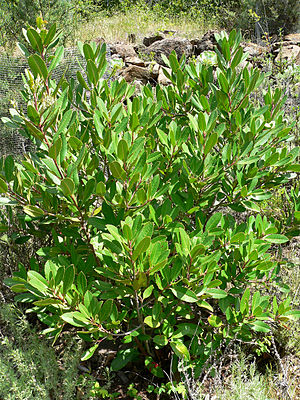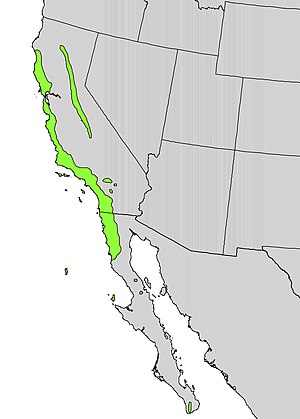Heteromeles arbutifolia
| Heteromeles arbutifolia | ||||||||||||
|---|---|---|---|---|---|---|---|---|---|---|---|---|

Heteromeles arbutifolia in the natural habitat |
||||||||||||
| Systematics | ||||||||||||
|
||||||||||||
| Scientific name | ||||||||||||
| Heteromeles arbutifolia | ||||||||||||
| ( Lindl. ) M. Roem. |
Heteromeles arbutifolia ( English toyon, Christmas berry, California holly ), is a species of the rose family. It is a common perennial shrub native to southwest Oregon , California , Baja California, and British Columbia . It is the only species in the genus Heteromeles .
H. arbutifolia is an outstanding part of the coastal shrub communities. It is also found in the drought-dominated chaparral and in mixed oak forests in California.
description
Heteromeles arbutifolia normally becomes 2… 5 m (rarely, in the shade up to 10 m) high and has a rounded or irregular tip. Its leaves are evergreen , arranged alternately, sharply toothed, have short petioles and are 5… 10 cm long and 2… 4 cm wide. In early summer the shrub produces white flowers 6… 10 mm in diameter, which form dense terminal panicles . The flowering wedding is in June.
The five petals are rounded. The fruit is a small apple fruit 5… 10 mm in diameter, bright red and berry-like, which is produced in large numbers, ripens in autumn and remains on the plant well into winter.
ecology
The flowers are visited by butterflies and have a mild hawthorn- like odor. The fruits are eaten by birds, including mockingbirds of the genera mime , Nesomimus and Melanotis ( English mockingbirds ) and robins , cedar waxwings and hermit thrushes . Also mammals such as coyotes and bears eat the apples and spread the plant.
use
Cultivation
Heteromeles arbutifolia can be grown in gardens on well-drained soil. It is cultivated as an ornamental plant north to south of England and can withstand temperatures as low as −12 ° C. In winter, the bright red apples (which the birds greedily attack) are visually appealing.
Like other species in the tribe Pyreae of the rose family, there are a number of cultivars of H. arbutifolia , which, however, are sensitive to fire blight . It survives with little water, so it is suitable for dry gardens. In addition, it does not pose a fire hazard as with some other plants of the chaparral .
Traditional use
The apples provided food for local Indian tribes such as the Chumash , Tongva and Tataviam . They can also be made into jelly. The Indians also used the leaves to make a tea that was supposed to relieve stomach ache. The apples, on the other hand, were usually dried and stored to be eaten later cooked in porridge or pancakes. The white settlers later added sugar to make custard and wine .
Occasionally the fresh apples are eaten raw or mixed with water to make a drink, despite their floury consistency, their astringent effect and their sour taste.
toxicity
H. arbutifolia apples are acidic and astringent. They contain small amounts of cyanogenic glycosides , which u. a. disintegrate to hydrocyanic acid . This is removed by boiling.
legislation
In the 1920s, around Christmas time, collecting the branches of Heteromeles arbutifolia became so popular in Los Angeles that the state of California passed a law prohibiting collecting on public land, non-collector land, or land that does not own it allowed in writing (CA Penal Code § 384a).
H. arbutifolia was recognized as an official native heraldic plant by the Los Angeles City Council on April 17, 2012.
Namesake for Hollywood
It is widely believed that the spread of H. arbutifolia in the hills above Los Angeles is the reason for the name Hollywood . However, Hollywood got its name for a much more mundane reason: A wealthy man liked the sound of the name. Harvey Henderson Wilcox, a wealthy Kansas prohibitionist, and his wife Daeida acquired 120 acres of apricot and fig groves near the Cahuenga Pass for $ 150 an acre in 1886. Wilcox, a die-hard businessman, realized he could make a lot of money by dividing the land into smaller plots and selling them for $ 1,000 apiece. Thus the ownership of Wilcox, which later became known as Hollywood, was established.
A year later, while on a train trip to Ohio, Daeida Wilcox befriended a wealthy fellow traveler who had just bought good property in Illinois. His name was Hollywood. Legend has it that Daeida Wilcox was so taken with the name that upon her return to California, she encouraged her husband to transfer the name to her property. The name became immortal on February 1, 1887, when Wilcox filed a map of the land division with the Los Angeles County Land Office that made the name "Hollywood" official.
Taxonomy
The genera Photinia , Aronia , Pourthiaea and Stranvaesia were combined again and again by different taxonomists. The genus Heteromeles was monotypical when it was first described by Max Joseph Roemer and closed to Photinia arbutifolia Lindl. (1820), whereby H. arbutifolia (Lindl.) M. Roem became an illegitimate name because it included the type specimen of the genus Photinia . This was corrected by protecting the name as nomen conservandum , which is why the name is often referred to as Heteromeles M. Roem. nom. cons. (1847) is executed.
Synonyms
eFloras.org , a Missouri Botanical Garden project , lists the following synonyms:
- Photinia arbutifolia Lindl.
- Crataegus arbutifolia WTAiton nom. illegal.
- Heteromeles Fremontiana Decaisne
- Heteromeles salicifolia (C. Presl) Abrams
- Photinia salicifolia C. Presl
Individual evidence
- ^ Heteromeles arbutifolia . In: Jepson Flora Project . University of California, Berkeley. 1993. Retrieved May 21, 2019.
- ↑ James B. Phipps: Heteromeles M. Roemer, Fam. Nat. Syn. Monogr. 3: 100, 105, 1847. [name conserved] . In: Flora of North America , Volume 9 2015.
- ↑ a b James B. Phipps: Heteromeles arbutifolia (Lindley) M. Roemer, Fam. Nat. Syn. Monogr. 3: 105.1847 . In: Flora of North America . 2015. Retrieved May 21, 2019.
- ↑ a b Heteromeles arbutifolia . In: Jepson Flora Project . Regents of the University of California. Retrieved November 14, 2013.
- ↑ C. Michael Hogan: Toyon: Heteromeles arbutifolia (Lindl.) M. Roem. . September 16, 2008. Retrieved May 21, 2019.
- ^ Heteromeles arbutifolia . In: iNaturalist . Retrieved May 21, 2019.
- ^ Alan Kaplan, Alison Hawkes: Ask The Naturalist: How Important Are Red Toyon Berries To the Winter Food Chain? . In: Bay Nature . December 22, 2016. Accessed May 21, 2019.
- ^ Austin Hagan, Edward Sikora, William Gazaway, Nancy Kokalis-Burelle: Fire Blight on Fruit Trees and Woody Ornamentals . Alabama A&M and Auburn Universities. 2004. Retrieved May 21, 2019.
- ^ Heteromeles Species, California Christmasberry, California Holly, Toyon . In: Dave's Garden . Retrieved May 21, 2019.
- ^ Ethnobotany of southern California native plants: Toyon (Heteromeles arbutifolia) . Retrieved May 21, 2019.
- ↑ John McKinney: California Holly Adds Color to Trail Up Mt. Hollywood . In: Los Angeles Times , Dec 6, 1986, p. 12.
- ↑ California Penal Code Section 384a archiveurl = https: //web.archive.org/web/20090627103906/http: //www.leginfo.ca.gov/cgi-bin/displaycode? Section = pen & group = 00001-01000 & file = 369a- 402c . June 27, 2009. Archived from the original on June 27, 2009. Info: The archive link was automatically inserted and not yet checked. Please check the original and archive link according to the instructions and then remove this notice. Retrieved May 21, 2019.
- ↑ Item No. (28) . In: Journal / Council Proceedings . LA City Council. Retrieved November 23, 2013.
- ↑ California Holly: How Hollywood Didn't Get its Name . December 18, 2013. Retrieved January 15, 2019.
- ^ A b G. L. Nesom, K. Gandhi: (1884-1885) Proposals to conserve the names Photinia , with a conserved type, and Heteromeles (Rosaceae) . In: Taxon . 58, No. 1, 2009, pp. 310-311.
- ↑ International Code of Nomenclature for algae, fungi, and plants: Appendices II-VIII (Appendix III) .
- ↑ NJ Turland et al. (Ed.): International Code of Nomenclature for algae, fungi, and plants (Shenzhen Code) adopted by the Nineteenth International Botanical Congress Shenzhen, China, July 2017 , electronic. Edition, International Association for Plant Taxonomy, Glashütten 2018 (accessed June 27, 2018).
- ↑ * Crataegus arbutifolia WT Aiton . In: Tropicos.org . Retrieved November 11, 2016.
Web links
- Heteromeles salicifolia in the Germplasm Resources Information Network (GRIN), USDA , ARS , National Genetic Resources Program. National Germplasm Resources Laboratory, Beltsville, Maryland.
- Michael Hogan (2008) Toyon: Heteromeles arbutifolia , GlobalTwitcher.com, ed. N. Stromberg ( page no longer available )
- Photos of flowers and fruits of the species
- University of Michigan: Dearborn - Native American Ethnobotany ( Heteromeles arbutifolia ) (English)
- Los Angeles City Clerk - Council Files: Toyon (English)
- CalFlora database: Heteromeles arbutifolia (English)
- The Living Wild Project: Toyon (English)
- USDA Plants Profile for Heteromeles arbutifolia (toyon) (English)
- Heteromeles arbutifolia - Photo Gallery of the University of California (English)
